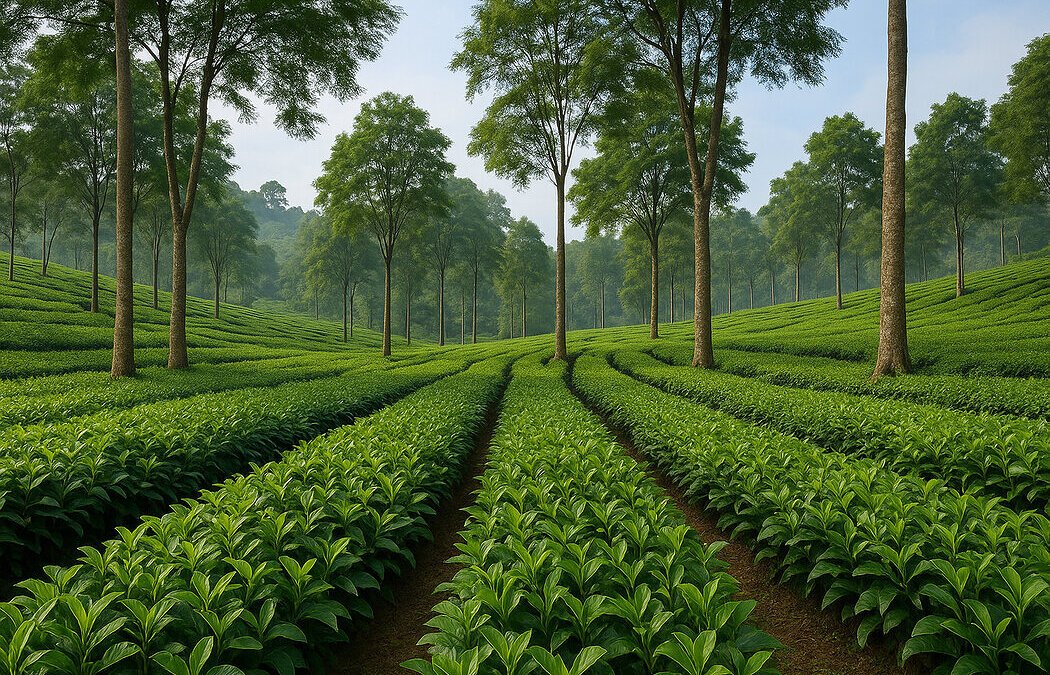Regenerative farming in India is no longer a fringe concept—it is steadily becoming the core of the nation’s agricultural transition. As climate challenges intensify and soil fertility depletes, India is witnessing a conscious shift from high-input, chemically driven practices toward sustainable, organic, and regenerative systems. This evolution is not only reshaping farming techniques but also redefining rural livelihoods, environmental policy, and global agricultural leadership. From tea gardens in the Himalayas to vegetable beds in tribal villages, India’s fields are being reimagined with purpose and resilience.
From Policy Vision to Village Transformation
The launch of the PM Dhan-Dhaanya Krishi Yojana by the Government of India marks a significant policy milestone. This ₹1.44 lakh crore initiative, spread across six years and over 100 districts, aims to empower 1.7 crore farmers through targeted interventions in infrastructure, sustainability, and value-chain development. But unlike earlier schemes focused primarily on mechanization or irrigation, this program places a clear emphasis on organic farming, regenerative soil practices, and crop diversification. It seeks to integrate traditional knowledge with scientific planning—an approach long demanded by grassroots agronomists and farmer associations.
India’s agricultural output has often been benchmarked in terms of yield per hectare or export volume. But this scheme attempts to broaden the metric—recognizing soil health, rural income stability, and ecological balance as indicators of success. The inclusion of capacity-building for natural farming and subsidies for bio-based inputs is a move toward decoupling productivity from chemical dependence.
In states like Andhra Pradesh, this policy vision has taken on measurable form. The state is pushing to reduce its chemical fertiliser usage by 11%, aiming to replace over 4 lakh tonnes with bio-fertilisers, nano-fertilisers, and organic composts. Training sessions, soil tests, and community seed banks are being set up at the panchayat level. The shift is not abrupt—it is supported by state-backed transitional mechanisms that allow farmers to move away from urea or DAP without risking crop loss.
Localised Innovation Rooted in Tradition
The success of any ecological transition in farming lies not in top-down mandates, but in the ground-level shifts led by communities themselves. This is evident in Uttar Pradesh, where the Gram-Urja model has introduced household-level biogas units in villages near Lucknow. These units serve dual purposes: replacing traditional LPG and firewood usage, and generating slurry-based organic fertiliser. The impact is multifold. Women save hours otherwise spent collecting firewood. Local methane emissions are captured rather than released. Most importantly, the resultant composted fertiliser reduces market dependence and enhances soil quality.
In Jharkhand, a similar story is emerging—though driven by a different set of forces. Over 25,000 women across tribal districts have been trained in regenerative farming. Unlike conventional monoculture or plough-intensive models, these farmers use multi-layer vegetable beds, intercropping, and vermiculture-based composting to grow diversified crops year-round. Without relying on external inputs, their land is now producing higher returns, while reducing pest cycles and erosion. Many of these collectives now sell directly in local haats, bypassing middlemen and increasing their income stability.

Kerala’s Crop Reorientation
Kerala’s farming narrative has undergone a quiet metamorphosis. Once dominated by rubber, pepper, and coconut plantations, the state is witnessing a significant shift toward exotic fruit cultivation. Dragon fruit, rambutan, avocado, durian—once rare and expensive imports—are now being grown across Palakkad, Wayanad, and Thrissur. A ₹30 crore government scheme is backing this diversification, helping farmers with sapling procurement, post-harvest training, and direct market linkages.
What makes this transition noteworthy is not just the economic return—though many report income increases of 25–40%—but the organic alignment of these crops. Most of them thrive without heavy pesticide usage and require controlled irrigation. Their cultivation supports agri-tourism, which Kerala is increasingly tapping into as part of its eco-brand.
The Rise of Matcha and Niche Organic Cultures
In a sharp contrast to staple grain farming, another niche but high-revenue trend is taking shape in hill states like Assam, Darjeeling, Nilgiris, and Himachal Pradesh—matcha tea cultivation. Traditionally a Japanese product, matcha’s demand in India’s wellness and export market has skyrocketed, with premium variants fetching between ₹3,500 and ₹20,000 per kilogram.
The cultivation of matcha aligns with organic and regenerative principles: shade-grown leaves, zero chemical exposure, hand-harvested batches, and stone-ground processing. Startups in this space are helping local tea farmers switch from CTC (crush-tear-curl) formats to artisanal matcha through mentorship and e-commerce support. Social media virality has further fueled interest, making matcha not just a trend but a case study in youth-led agricultural reinvention.
Northeast India’s Organic Identity
The Northeast has long remained agriculturally under-leveraged despite its biodiversity and clean air-water ecosystems. Now, under renewed national focus, states like Sikkim, Meghalaya, and Assam are emerging as India’s organic pioneers. Sikkim’s status as the first 100% organic state has encouraged others to create pesticide-free zones and certification corridors.
Community-based farming, low chemical legacy, and traditional seed use give the region a natural edge. The government is now creating dedicated export clusters for spices, ginger, black rice, and turmeric from this region—products that fetch a premium in Western and Middle Eastern markets due to their organic provenance.
Socioeconomic Implications
This nationwide turn toward regenerative agriculture is also a lever for social transformation. Women’s cooperatives, self-help groups, and tribal societies are gaining not just income but bargaining power. Organic farmer producer organizations (FPOs) are being integrated into e-NAM (National Agricultural Market), allowing better price discovery and reduced dependency on local traders.
Environmental externalities are also being reduced. Regenerative farming methods contribute to carbon sequestration, improve water retention, and prevent soil degradation. Unlike high-input models, which often leave farmers debt-ridden, these practices are low-cost, low-risk, and scalable even for marginal landholders.
Environmental and Global Context
Globally, countries are watching India’s regenerative pivot with interest. As the EU, US, and Japan tighten import standards related to residue-free produce and traceability, Indian exports can benefit if certification and supply chains keep pace. There is increasing collaboration with international research institutions on bio-fertiliser innovations, carbon credits for soil restoration, and digital traceability tools.
India’s moves also support the United Nations’ Sustainable Development Goals (SDGs), particularly Goal 2 (Zero Hunger), Goal 12 (Responsible Consumption and Production), and Goal 13 (Climate Action). These alignments open doors to international grants and trade preferences, especially under WTO-compliant eco-labeling frameworks.
A Future Defined by Balance
The era of “grow more at any cost” is being replaced by “grow better, grow balanced.” The new Indian farmer is not just a cultivator but an environmental steward, a climate responder, and an entrepreneur. Whether it is a tea grower in Nilgiris exporting matcha, or a homemaker in Lucknow managing a biogas plant, the actors of this revolution are real, grounded, and growing.
Quiet Momentum, Bold Direction
While headlines often focus on agrarian distress or market volatility, there is another story unfolding—less dramatic but far more hopeful. India’s regenerative farming movement is a bottom-up renaissance that brings together tradition, science, and sustainability. The government is supporting it, the market is rewarding it, and the climate crisis is necessitating it.
This silent shift could well become the defining agricultural narrative of the decade—one that not only feeds a nation but heals its soil, empowers its people, and earns global respect.
AryaLekh (DoFollow)
Income Inequality in India: 2024–2025 Humanitarian Decline and National Crisis
Caste Census 2025: Awakening of the Youth Voter
Source (DoFollow)
PM Dhan-Dhaanya Krishi Yojana
https://pib.gov.in/PressReleasePage.aspx?PRID=2012226
(Source: Press Information Bureau, Government of India)
Andhra Pradesh Bio-Fertiliser Program
https://timesofindia.indiatimes.com/city/vijayawada/andhra-pradesh-pushes-bio-fertiliser-revolution-in-agriculture/articleshow/122770691.cms
Regenerative Farming Overview (Food and Agriculture Organization)
https://www.fao.org/agroecology/overview/en/
(Source: FAO of the United Nations)
Sikkim: 100% Organic State Initiative
https://www.downtoearth.org.in/news/agriculture/sikkim-becomes-india-s-first-organic-state-52496
Matcha Tea Demand and Export Opportunity
https://indiatimes.com/trending/why-indian-farmers-are-chasing-matcha-sarthak-ahujas-take-on-its-rs-20000-per-kg-price-tag-goes-viral-664397.html



